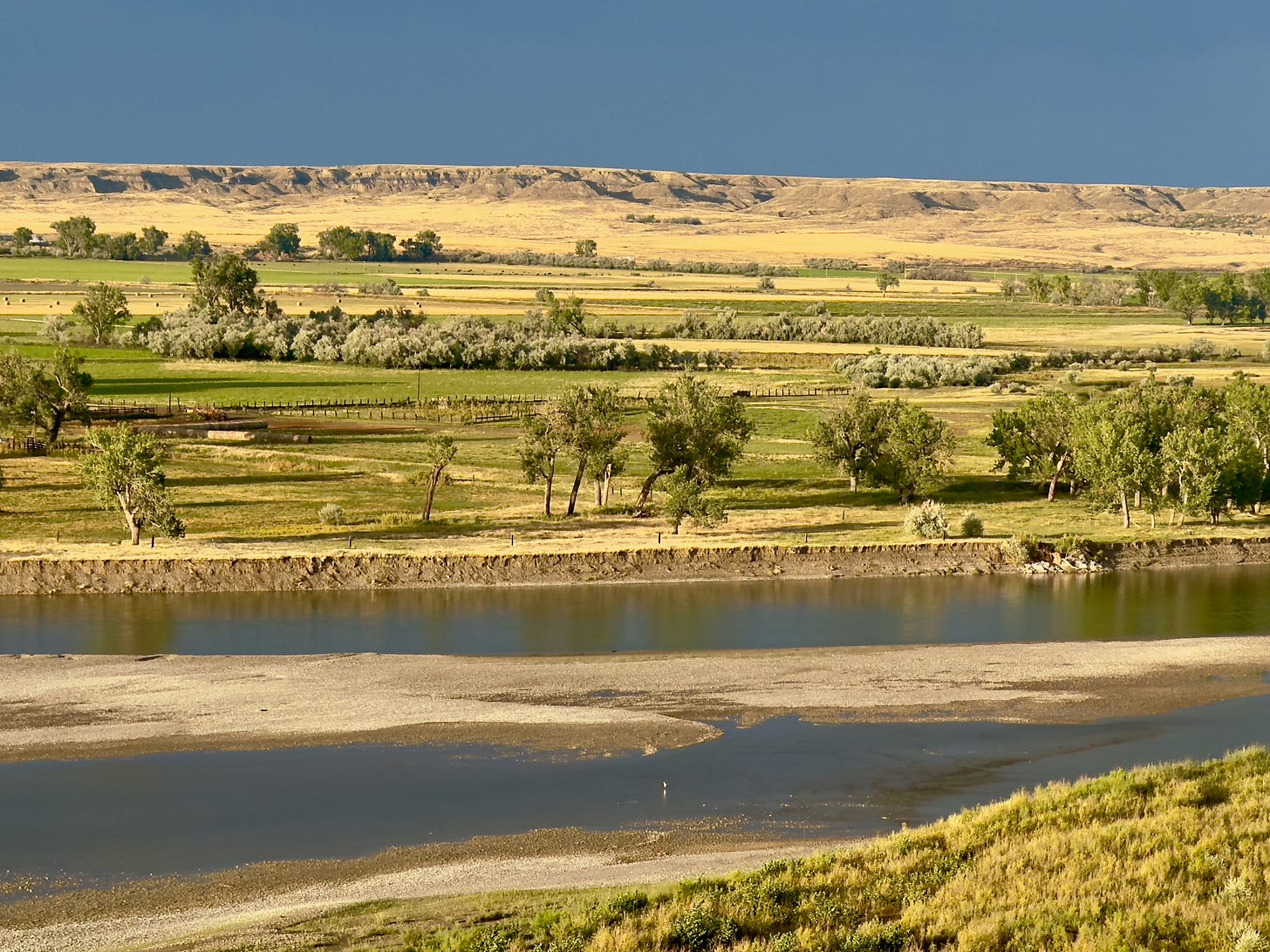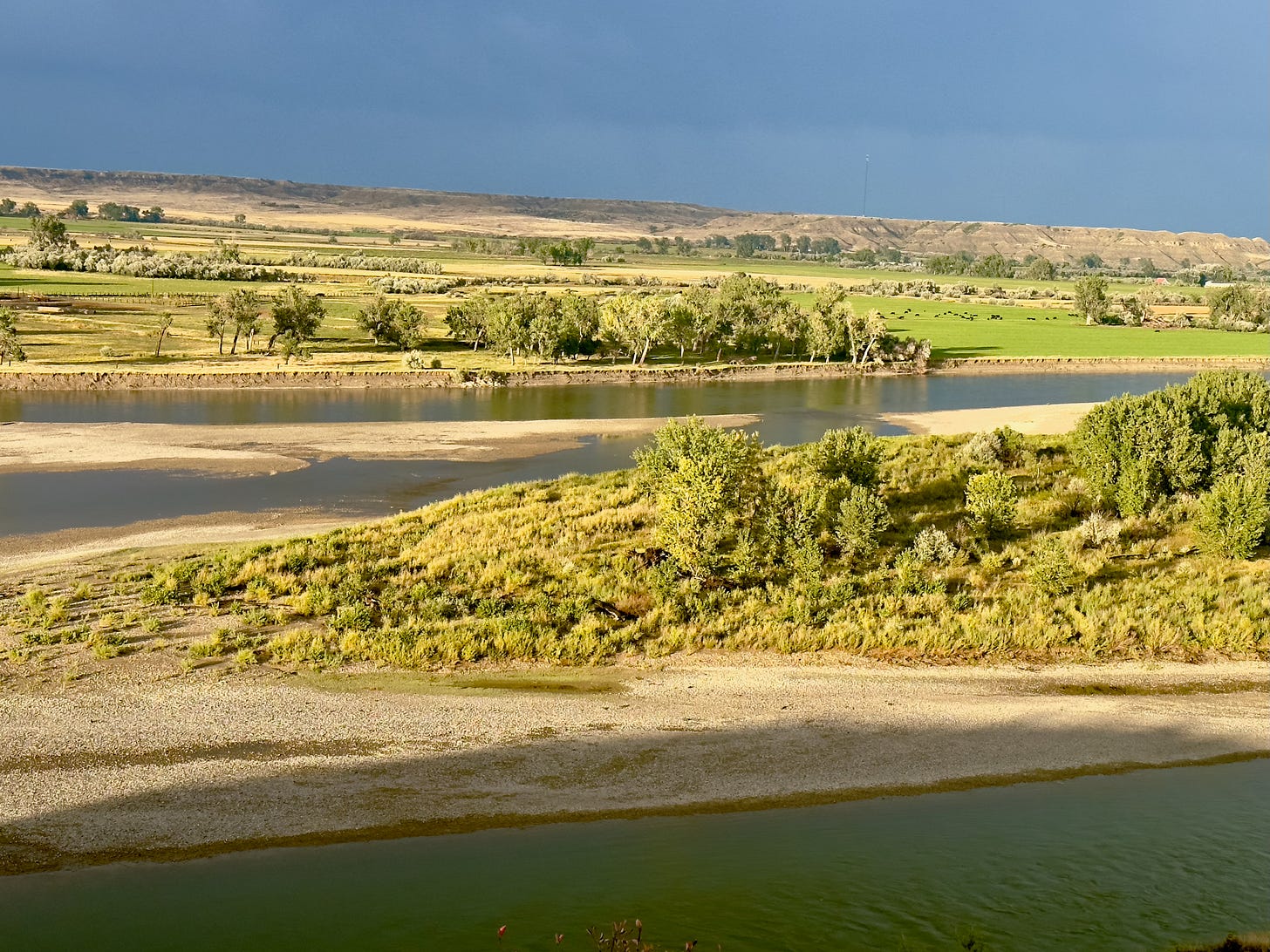When I heard the severe weather alert on the radio, I figured a back road wasn’t the place to be. Better to get to an interstate post haste and find myself a rest stop. Though I discounted the tornado element, I figured the bathrooms there would offer safe shelter should worse come to worse. I made for I-94 once again and soon found a rest stop.
Uniquely among interstate rest stops I had visited before this one was elevated above much of the surrounding landscape. Not ideal should the shit hit the fan, but wonderfully scenic. When I exited the car I could see the Yellowstone River, which, though at low ebb, provided a nice foreground for the green hills and black skies on the other side.
(Given its place of origin, you might think the Yellowstone River would wend its way to the Pacific, perhaps via the Snake and Columbia Rivers. But due to the vagaries of topography as represented by the Continental Divide, Yellowstone River water and sediments end up in the Gulf of Mexico, by way of the Missouri and Mississippi rivers. Thousands of feet of the sediments deposited in the Mississippi River Delta over the last five million years were eroded off the Rocky Mountains.)
When I arrived at the rest stop there were only two cars, one of which belonged to the custodian. The storm didn’t seem to be immanent, the low sun was still shining, the dark clouds seemed distant. Just a stiff breeze hinting at things to come. So I decided to get some photographs with my iPhone and walked to the other end of the large parking lot for a better vantage.
The late afternoon light just kept getting better and better, the contrast of light and dark increasingly accentuated. I considered returning to the car for my DSLR camera, but I didn’t want to miss any of the subtle changes in the scene as the sun sank. Mostly I just gazed at the beautiful scene. The wind began to intensify but I remained until everything was in shadow. I returned to the car before the rain commenced. While still outside I could hear rumbling thunder accompanied by lighting streaks. I looked forward to the show because there is no better place to be during a severe thunderstorm than in a stationary vehicle. The car acts as a Faraday cage when lighting strikes, conducting the electricity to the ground around the auto’s exterior. And if you are not driving there is no need to worry about bad visibility. Just hope that it doesn’t hail. (The worst place to experience a severe thunderstorm, as I have many times, is in a tent at high elevations.)
As thunderstorms go, it was a damned good show. I gave it four out of five stars. It was in three parts with brief intermissions. I just wished it had lasted longer. When it was over I no longer had an excuse to remain parked at the rest stop, but with no better options, I decided to spend the night there. The problem was the custodian. Once the storm blew over, he exited his vehicle and looked my way. He was at least 30 yards away, so I couldn’t see his facial expression, but I had a sense, perhaps paranoid, that he wanted me out of there. Mine was now the only vehicle parked there other than his.
It is perfectly legal in California to spend the night at a rest stop. But in California a lot of things are legal that aren’t legal elsewhere. I remember when California was the only state where you could make a right turn on a red light. So I consulted google on the phone: “Is it legal to spend the night at a rest stop in Montana?” YES! As long as you only occupy one space (check) and stay for less than 12 hours (no problem). Armed with that knowledge, I just stared back at the custodian when he looked my way. But after my initial relief, I was confronted with the reality of spending another night in my car.
Back on the Craton Again
Here is what was good about that night. It was free of hulking semi-trailer trucks. Hence, I didn’t have the background noise of their powerful engines idling. Even better, no other automobiles of any kind arrived during the night. On the con side, sleeping in a car seat, which, no matter how reclined, could not remotely approximate a bed. I slept only intermittently in 45-minute bursts. Each time I awoke I was stunned at how little time had passed.
I started my engine before sunrise, well before my 12-hour limit, only half awake, hungry and craving coffee. I briefly considering firing up my Pocket Rocket stove on the pavement to at least boil water for some instant coffee but figured that had to be a violation of some ordinance. I settled for dry cereal augmented with dried cranberries. The coffee would have to come later. Once partly fortified, I was off to the Dayton, Wyoming, eastern gateway to the northern Bighorn Mountains.
For me, the Bighorns exceed any other mountain range in dramatic profile and general beauty. Even the Grand Tetons. And the Bighorns are visited by far fewer humans than the Tetons. There is no Jackson Hole, no airport catering to the private jets of billionaires, visiting their third or fourth or fifth residences. Just Greybull, Lovell and Worland on the west side, Dayton and Buffalo on the east, each far less touristed than Jackson Hole.
The Bighorns are a relatively isolated range of the larger Rocky Mountain complex. Only the Black Hills lay further east. The Bighorns extend for about 200 miles north to south, the highest point—Cloudy Peak—is over 13,000 feet. Three scenic roads traverse the range, Highways 14, 14A, and 16. I have enjoyed traveling all three in each direction over the years, stopping at every opportunity, at turnouts or just wide verges off the paved road.. Each route begins in low sagebrush country and ascends, sometimes with breathtaking steepness to the alpine zone. Highway 14A is one of the steepest paved roads I’ve ever been on.
The drives are significantly enhanced for me by signs posted by the state highway department in cooperation with the Wyoming Geological survey. These signs indicate the geological formation through which you are passing and its age. I always stop at or near each new sign to explore the rocks in the vicinity. As you ascend in elevation, the rocks get older. The youngest, at the base—called the Chugwater Formation—are as old as the oldest Sierran Rocks. So those at the summit are extremely old, as old as those of the Superior Craton in Minnesota. For the Bighorns are on another craton, called the Wyoming Craton, around which all of the western United States was constructed.





